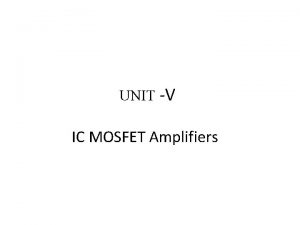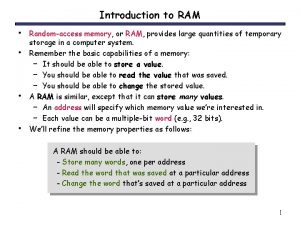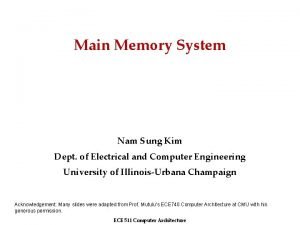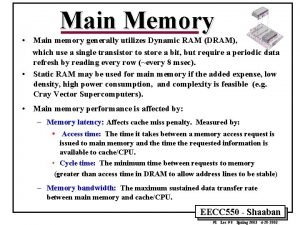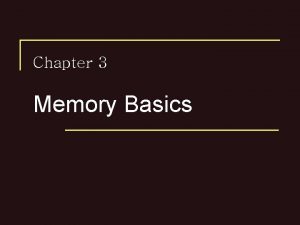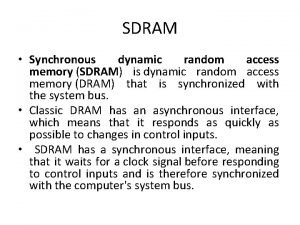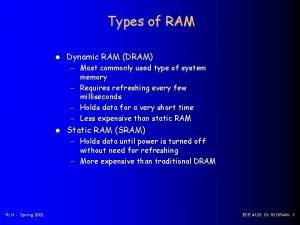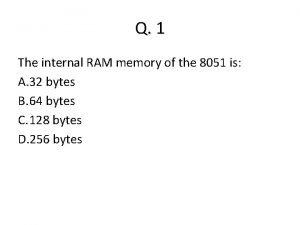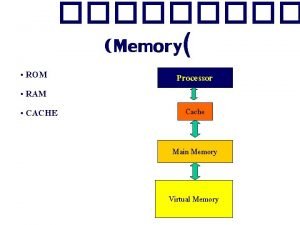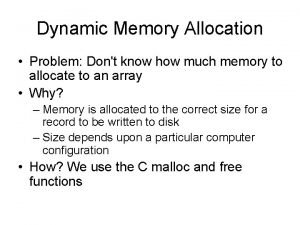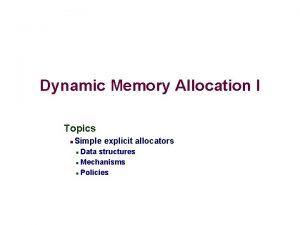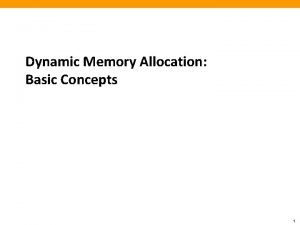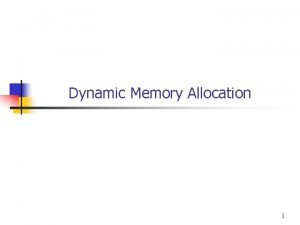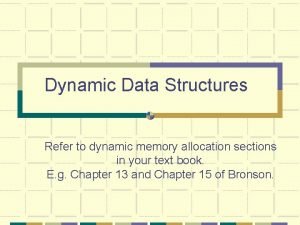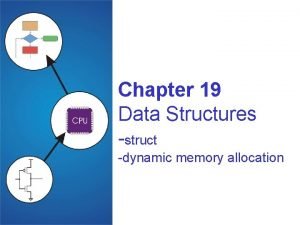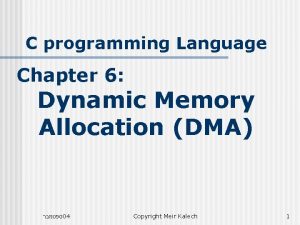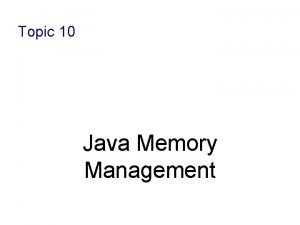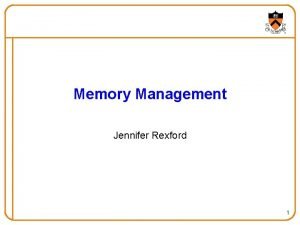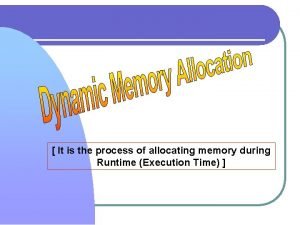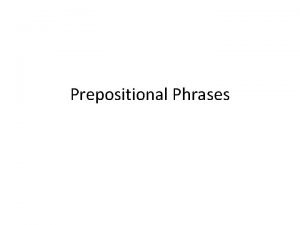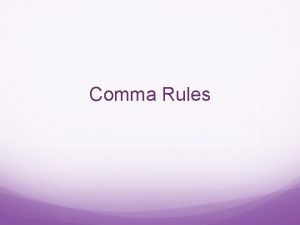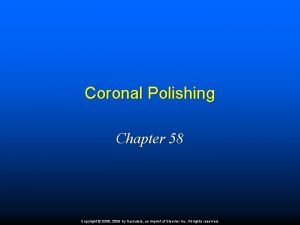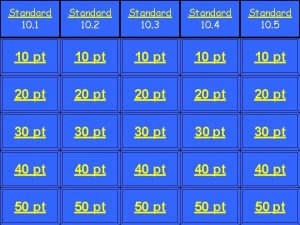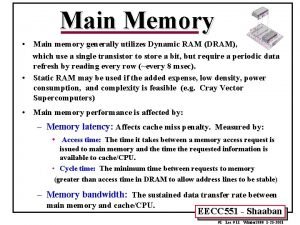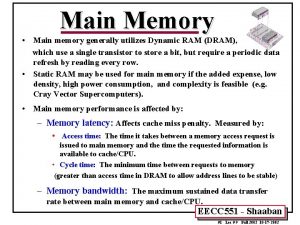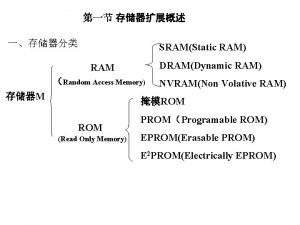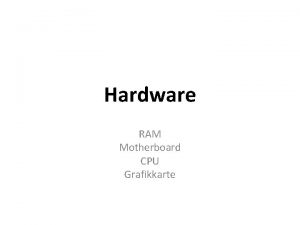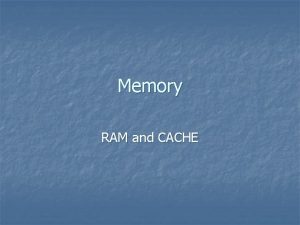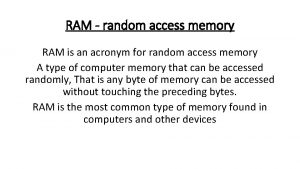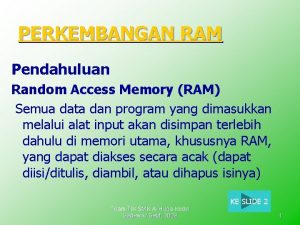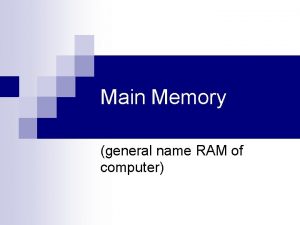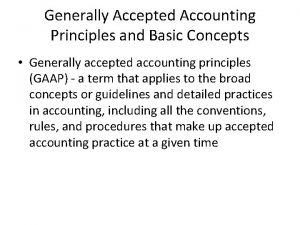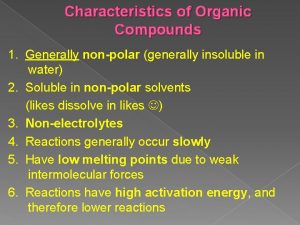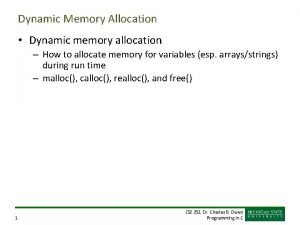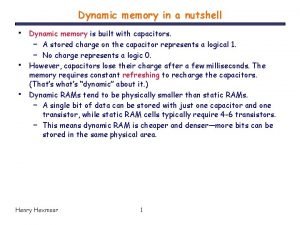Main Memory Main memory generally utilizes Dynamic RAM

























































- Slides: 57

Main Memory • Main memory generally utilizes Dynamic RAM (DRAM), which use a single transistor to store a bit, but require a periodic data refresh by reading every row (~every 8 msec). • Static RAM may be used for main memory if the added expense, low density, high power consumption, and complexity is feasible (e. g. Cray Vector Supercomputers). • Main memory performance is affected by: – Memory latency: Affects cache miss penalty. Measured by: • Access time: The time it takes between a memory access request is issued to main memory and the time the requested information is available to cache/CPU. • Cycle time: The minimum time between requests to memory (greater than access time in DRAM to allow address lines to be stable) – Memory bandwidth: The maximum sustained data transfer rate between main memory and cache/CPU. EECC 551 - Shaaban #1 lec # 8 Winter 2002 1 -15 -2003

Logical DRAM Organization (16 Mbit) Column Decoder … Sense Amps & I/O 14 Row/Column Address Data In Row Decoder A 0…A 13 0 D Memory Array (16, 384 x 16, 384) Q Data Out Word Line Control Signals: Row Access Strobe (RAS): Low to latch row address Column Address Strobe (CAS): Low to latch column address Write Enable (WE) Output Enable (OE) Storage Cell EECC 551 - Shaaban #2 lec # 8 Winter 2002 1 -15 -2003

Key DRAM Speed Parameters • Row Access Strobe (RAS)Time: – Minimum time from RAS (Row Access Strobe) line falling to the first valid data output. – A major component of memory latency. – Only improves 5% every year. • Column Access Strobe (CAS) Time/data transfer time: – The minimum time required to read additional data by changing column address while keeping the same row address. – Along with memory bus width, determines peak memory bandwidth. EECC 551 - Shaaban #3 lec # 8 Winter 2002 1 -15 -2003

From Technology Trends Capacity 2 x in 3 years 4 x in 3 years Logic: DRAM: Disk: Speed (latency) 2 x in 3 years 2 x in 10 years DRAM Generations Year Size 1980 1983 1986 1989 1992 1996 1998 2000 2002 64 Kb 256 Kb 1 Mb 4 Mb 16 Mb 64 Mb 128 Mb 256 Mb 512 Mb RAS (ns) CAS (ns) 150 -180 120 -150 100 -120 80 -100 60 -80 50 -70 45 -65 40 -60 75 50 25 20 15 12 10 7 5 8000: 1 (Capacity) Cycle Time 250 ns 220 ns 190 ns 165 ns 120 ns 110 ns 100 ns 90 ns 80 ns 15: 1 (~bandwidth) 3: 1 (Latency) EECC 551 - Shaaban #4 lec # 8 Winter 2002 1 -15 -2003

Memory Hierarchy: The motivation • The gap between CPU performance and main memory has been widening with higher performance CPUs creating performance bottlenecks for memory access instructions. • The memory hierarchy is organized into several levels of memory with the smaller, more expensive, and faster memory levels closer to the CPU: registers, then primary Cache Level (L 1), then additional secondary cache levels (L 2, L 3…), then main memory, then mass storage (virtual memory). • Each level of the hierarchy is a subset of the level below: data found in a level is also found in the level below but at lower speed. • Each level maps addresses from a larger physical memory to a smaller level of physical memory. • This concept is greatly aided by the principal of locality both temporal and spatial which indicates that programs tend to reuse data and instructions that they have used recently or those stored in their vicinity leading to working set of a program. EECC 551 - Shaaban #5 lec # 8 Winter 2002 1 -15 -2003

Memory Hierarchy: Motivation Processor-Memory (DRAM) Performance Gap 100 CPU Processor-Memory Performance Gap: (grows 50% / year) 10 DRAM 1 µProc 60%/yr. DRAM 7%/yr. 1980 1981 1982 1983 1984 1985 1986 1987 1988 1989 1990 1991 1992 1993 1994 1995 1996 1997 1998 1999 2000 Performance 1000 EECC 551 - Shaaban #6 lec # 8 Winter 2002 1 -15 -2003

Processor-DRAM Performance Gap Impact: Example • To illustrate the performance impact, assume a single-issue pipelined CPU with CPI = 1 using non-ideal memory. • Ignoring other factors, the minimum cost of a full memory access in terms of number of wasted CPU cycles: Year CPU speed MHZ 1986: 8 1989: 33 1992: 60 1996: 200 1998: 300 2000: 1000 2002: 2000 CPU cycle ns 125 30 16. 6 5 3. 33 1. 5 Memory Access Minimum CPU cycles or instructions wasted ns 190 165 120 110 100 90 80 190/125 - 1 = 0. 5 165/30 -1 = 4. 5 120/16. 6 -1 = 6. 2 110/5 -1 = 21 100/3. 33 -1 = 29 90/1 - 1 = 89 80/. 5 - 1 = 159 EECC 551 - Shaaban #7 lec # 8 Winter 2002 1 -15 -2003

Memory Hierarchy: Motivation The Principle Of Locality • Programs usually access a relatively small portion of their address space (instructions/data) at any instant of time (program working set). • Two Types of locality: – Temporal Locality: If an item is referenced, it will tend to be referenced again soon. – Spatial locality: If an item is referenced, items whose addresses are close will tend to be referenced soon. • The presence of locality in program behavior, makes it possible to satisfy a large percentage of program access needs (both instructions and operands) using memory levels with much less capacity than program address space. EECC 551 - Shaaban #8 lec # 8 Winter 2002 1 -15 -2003

Levels of The Memory Hierarchy Part of The On-chip CPU Datapath 16 -256 Registers One or more levels (Static RAM): Level 1: On-chip 16 -64 K Level 2: On or Off-chip 128 -512 K Level 3: Off-chip 1 M-16 M DRAM, RDRAM 16 M-16 G Interface: SCSI, RAID, IDE, 1394 4 G-100 G Farther away from The CPU Lower Cost/Bit Higher Capacity Increased Access Time/Latency Lower Throughput Registers Cache Main Memory Magnetic Disc Optical Disk or Magnetic Tape EECC 551 - Shaaban #9 lec # 8 Winter 2002 1 -15 -2003

A Typical Memory Hierarchy (With Two Levels of Cache) Faster Larger Capacity Processor Control Registers Datapath Second Level Cache (SRAM) L 2 On-Chip Level One Cache L 1 Main Memory (DRAM) Speed (ns): 1 s 100 s Size (bytes): 100 s Ks Ms Virtual Memory, Secondary Storage (Disk) Tertiary Storage (Tape) 10, 000 s 10, 000, 000 s (10 s ms) (10 s sec) Gs Ts EECC 551 - Shaaban #10 lec # 8 Winter 2002 1 -15 -2003

Levels of The Memory Hierarchy EECC 551 - Shaaban #11 lec # 8 Winter 2002 1 -15 -2003

SRAM Organization Example 4 words X 3 bits each Static RAM (SRAM) Six transistors per bit No refresh needed 8 to 16 times faster than DRAM Not suitable for main memory Because: 8 to 16 times more expensive Much less chip density than DRAM More power consumption But suitable for on-chip or off-chip cache EECC 551 - Shaaban #12 lec # 8 Winter 2002 1 -15 -2003

Memory Hierarchy Operation • If an instruction or operand is required by the CPU, the levels of the memory hierarchy are searched for the item starting with the level closest to the CPU (Level 1 cache): – If the item is found, it’s delivered to the CPU resulting in a cache hit without searching lower levels. – If the item is missing from an upper level, resulting in a miss, the level just below is searched. – For systems with several levels of cache, the search continues with cache level 2, 3 etc. – If all levels of cache report a miss then main memory is accessed for the item. • CPU « cache « memory: Managed by hardware. – If the item is not found in main memory resulting in a page fault, then disk (virtual memory), is accessed for the item. • Memory « disk: Managed by hardware and the operating system. EECC 551 - Shaaban #13 lec # 8 Winter 2002 1 -15 -2003

Memory Hierarchy: Terminology • A Block: The smallest unit of information transferred between two levels. • Hit: Item is found in some block in the upper level (example: Block X) – Hit Rate: The fraction of memory access found in the upper level. – Hit Time: Time to access the upper level which consists of RAM access time + Time to determine hit/miss • Miss: Item needs to be retrieved from a block in the lower level (Block Y) – Miss Rate = 1 - (Hit Rate) – Miss Penalty: Time to replace a block in the upper level + Time to deliver the block the processor • Hit Time << Miss Penalty Lower Level To Processor Upper Level Memory Blk X From Processor Blk Y EECC 551 - Shaaban #14 lec # 8 Winter 2002 1 -15 -2003

Cache Concepts • Cache is the first level of the memory hierarchy once the address leaves the CPU and is searched first for the requested data. • If the data requested by the CPU is present in the cache, it is retrieved from cache and the data access is a cache hit otherwise a cache miss and data must be read from main memory. • On a cache miss a block of data must be brought in from main memory to cache to possibly replace an existing cache block. • The allowed block addresses where blocks can be mapped into cache from main memory is determined by cache placement strategy. • Locating a block of data in cache is handled by cache block identification mechanism. • On a cache miss the cache block being removed is handled by the block replacement strategy in place. • When a write to cache is requested, a number of main memory update strategies exist as part of the cache write policy. EECC 551 - Shaaban #15 lec # 8 Winter 2002 1 -15 -2003

Cache Design & Operation Issues • Q 1: Where can a block be placed cache? (Block placement strategy & Cache organization) – Fully Associative, Set Associative, Direct Mapped. • Q 2: How is a block found if it is in cache? (Block identification) – Tag/Block. • Q 3: Which block should be replaced on a miss? (Block replacement) – Random, LRU. • Q 4: What happens on a write? (Cache write policy) – Write through, write back. EECC 551 - Shaaban #16 lec # 8 Winter 2002 1 -15 -2003

We will examine: examine • Cache Placement Strategies – Cache Organization • Locating A Data Block in Cache • Cache Replacement Policy • What happens on cache Reads/Writes • Cache write strategies • Cache write miss policies • Cache performance EECC 551 - Shaaban #17 lec # 8 Winter 2002 1 -15 -2003

Cache Organization & Placement Strategies Placement strategies or mapping of a main memory data block onto cache block frame addresses divide cache into three organizations: 1 Direct mapped cache: A block can be placed in one location only, given by: (Block address) MOD (Number of blocks in cache) 2 3 Fully associative cache: A block can be placed anywhere in cache. Set associative cache: A block can be placed in a restricted set of places, or cache block frames. A set is a group of block frames in the cache. A block is first mapped onto the set and then it can be placed anywhere within the set. The set in this case is chosen by: (Block address) MOD (Number of sets in cache) If there are n blocks in a set the cache placement is called n-way set-associative. EECC 551 - Shaaban #18 lec # 8 Winter 2002 1 -15 -2003

Cache Organization: Direct Mapped Cache A block can be placed in one location only, given by: (Block address) MOD (Number of blocks in cache) In this case: (Block address) MOD (8) 110 111 100 101 011 0 01 8 cache block frames 010 000 C a ch e (11101) MOD (1000) = 101 32 memory blocks cacheable 00 001 0 0101 0100 1 01101 1000 1 101 01 11 00 1 11101 M e m o ry EECC 551 - Shaaban #19 lec # 8 Winter 2002 1 -15 -2003

4 KB Direct Mapped Cache Example Tag field H it 1 K = 1024 Blocks Each block = one word A d d r e s s ( s h o w i n g b it p o s i tio n s ) 31 30 13 12 11 2 1 0 Index field B y te o ffs e t 10 20 Tag D a ta In d e x V a l id T ag D a ta 0 Can cache up to 232 bytes = 4 GB of memory 1 2 Mapping function: 1021 1022 Cache Block frame number = (Block address) MOD (1024) Block Address = 30 bits Tag = 20 bits Index = 10 bits 1023 20 32 Block offset = 2 bits EECC 551 - Shaaban #20 lec # 8 Winter 2002 1 -15 -2003

64 KB Direct Mapped Cache Example Tag field A d d re s s (s h o w in g b it p o s iti o n s ) 4 K= 4096 blocks 31 Each block = four words = 16 bytes H it Can cache up to 232 bytes = 4 GB of memory 16 1 5 16 Index field 4 32 1 0 12 2 B y te T ag Word select o ffs e t D a ta In d e x V B lo c k o f fs e t 1 6 b its 1 2 8 b its T ag D a ta 4 K e n trie s 16 32 32 Mux 32 Block Address = 28 bits Tag = 16 bits Index = 12 bits Block offset = 4 bits Mapping Function: Cache Block frame number = (Block address) MOD (4096) Larger blocks take better advantage of spatial locality EECC 551 - Shaaban #21 lec # 8 Winter 2002 1 -15 -2003

Cache Organization: Set Associative Cache O n e - w a y s e t a s s o c i a t iv e (d ire c t m a p p e d ) B lo c k T ag D a ta 0 T w o - w a y s e t a s s o c i a t iv e 1 Set 2 Tag D a ta 0 3 1 4 2 5 3 6 7 F o u r - w a y s e t a s s o c ia tiv e S et T ag D a ta Tag D a ta 0 1 E ig h t - w a y s e t a s s o c ia t iv e ( fu l ly a s s o c i a t i v e ) Tag D a ta Tag D a ta EECC 551 - Shaaban #22 lec # 8 Winter 2002 1 -15 -2003

Cache Organization Example EECC 551 - Shaaban #23 lec # 8 Winter 2002 1 -15 -2003

Locating A Data Block in Cache • Each block frame in cache has an address tag. • The tags of every cache block that might contain the required data are checked in parallel. • A valid bit is added to the tag to indicate whether this entry contains a valid address. • The address from the CPU to cache is divided into: – A block address, further divided into: • An index field to choose a block set in cache. (no index field when fully associative). • A tag field to search and match addresses in the selected set. – A block offset to select the data from the block. Block Address Tag Index Block Offset EECC 551 - Shaaban #24 lec # 8 Winter 2002 1 -15 -2003

Address Field Sizes Physical Address Generated by CPU Block Address Tag Block Offset Index Block offset size = log 2(block size) Index size = log 2(Total number of blocks/associativity) Tag size = address size - index size - offset size Number of Sets Mapping function: Cache set or block frame number = Index = = (Block Address) MOD (Number of Sets) EECC 551 - Shaaban #25 lec # 8 Winter 2002 1 -15 -2003

4 K Four-Way Set Associative Cache: MIPS Implementation Example A d dre s s Tag Field 31 3 0 12 11 10 9 8 V Tag D a ta V T ag D ata V T ag D a ta 1 2 254 255 22 Block Address = 30 bits Index = 8 bits Block offset = 2 bits 32 4 - to - 1 m u ltip le xo r H it Mapping Function: Tag 0 253 Can cache up to 232 bytes = 4 GB of memory Tag = 22 bits In d ex Index Field 8 22 1024 block frames Each block = one word 4 -way set associative 256 sets 3 2 1 0 Cache Set Number = (Block address) MOD (256) D a ta EECC 551 - Shaaban #26 lec # 8 Winter 2002 1 -15 -2003

Cache Replacement Policy • When a cache miss occurs the cache controller may have to select a block of cache data to be removed from a cache block frame and replaced with the requested data, such a block is selected by one of two methods: – Random: • Any block is randomly selected for replacement providing uniform allocation. • Simple to build in hardware. • The most widely used cache replacement strategy. – Least-recently used (LRU): • Accesses to blocks are recorded and the block replaced is the one that was not used for the longest period of time. • LRU is expensive to implement, as the number of blocks to be tracked increases, and is usually approximated. EECC 551 - Shaaban #27 lec # 8 Winter 2002 1 -15 -2003

Miss Rates for Caches with Different Size, Associativity & Replacement Algorithm Sample Data Associativity: Size 16 KB 64 KB 256 KB 2 -way LRU Random 5. 18% 5. 69% 1. 88% 2. 01% 1. 15% 1. 17% 4 -way LRU Random 4. 67% 5. 29% 1. 54% 1. 66% 1. 13% 8 -way LRU Random 4. 39% 4. 96% 1. 39% 1. 53% 1. 12% EECC 551 - Shaaban #28 lec # 8 Winter 2002 1 -15 -2003

Unified vs. Separate Level 1 Cache • Unified Level 1 Cache (Princeton Memory Architecture). A single level 1 cache is used for both instructions and data. • Separate instruction/data Level 1 caches (Harvard Memory Architecture): The level 1 (L 1) cache is split into two caches, one for instructions (instruction cache, L 1 I-cache) and the other for data (data cache, L 1 D-cache). Processor Control Unified Level One Cache L 1 Unified Level 1 Cache (Princeton Memory Architecture) Datapath Registers Datapath Processor L 1 I-cache L 1 D-cache Separate Level 1 Caches (Harvard Memory Architecture) EECC 551 - Shaaban #29 lec # 8 Winter 2002 1 -15 -2003

Cache Performance: Average Memory Access Time (AMAT), Memory Stall cycles • The Average Memory Access Time (AMAT): The number of cycles required to complete an average memory access request by the CPU. • Memory stall cycles per memory access: The number of stall cycles added to CPU execution cycles for one memory access. • For ideal memory: AMAT = 1 cycle, this results in zero memory stall cycles. • Memory stall cycles per average memory access = (AMAT -1) • Memory stall cycles per average instruction = Memory stall cycles per average memory access x Number of memory accesses per instruction = (AMAT -1 ) x ( 1 + fraction of loads/stores) Instruction Fetch EECC 551 - Shaaban #30 lec # 8 Winter 2002 1 -15 -2003

Cache Performance Princeton (Unified) Memory Architecture For a CPU with a single level (L 1) of cache for both instructions and data (Princeton memory architecture) and no stalls for cache hits: With ideal memory Total CPU time = (CPU execution clock cycles + Memory stall clock cycles) x clock cycle time Memory stall clock cycles = (Reads x Read miss rate x Read miss penalty) + (Writes x Write miss rate x Write miss penalty) If write and read miss penalties are the same: Memory stall clock cycles = Memory accesses x Miss rate x Miss penalty EECC 551 - Shaaban #31 lec # 8 Winter 2002 1 -15 -2003

Cache Performance Princeton (Unified) Memory Architecture CPUtime = Instruction count x CPI x Clock cycle time CPIexecution = CPI with ideal memory CPI = CPIexecution + Mem Stall cycles per instruction CPUtime = Instruction Count x (CPIexecution + Mem Stall cycles per instruction) x Clock cycle time Mem Stall cycles per instruction = Mem accesses per instruction x Miss rate x Miss penalty CPUtime = IC x (CPIexecution + Mem accesses per instruction x Miss rate x Miss penalty) x Clock cycle time Misses per instruction = Memory accesses per instruction x Miss rate CPUtime = IC x (CPIexecution + Misses per instruction x Miss penalty) x Clock cycle time EECC 551 - Shaaban #32 lec # 8 Winter 2002 1 -15 -2003

Memory Access Tree For Unified Level 1 Cache CPU Memory Access L 1 AMAT = L 1 Hit: % = Hit Rate = H 1 Access Time = 1 Stalls= H 1 x 0 = 0 ( No Stall) H 1 x 1 + (1 -H 1 ) x (M+ 1) Stall Cycles Per Access = AMAT - 1 = Miss Penalty H 1 = Level 1 Hit Rate 1 - H 1 = Level 1 Miss Rate L 1 Miss: % = (1 - Hit rate) = (1 -H 1) Access time = M + 1 Stall cycles per access = M x (1 -H 1) = 1 + M x ( 1 -H 1) M x (1 -H 1) EECC 551 - Shaaban #33 lec # 8 Winter 2002 1 -15 -2003

Cache Impact On Performance: An Example Assuming the following execution and cache parameters: – – Cache miss penalty = 50 cycles Normal instruction execution CPI ignoring memory stalls = 2. 0 cycles Miss rate = 2% Average memory references/instruction = 1. 33 CPU time = IC x [CPI execution + Memory accesses/instruction x Miss rate x Miss penalty ] x Clock cycle time CPUtime with cache = IC x (2. 0 + (1. 33 x 2% x 50)) x clock cycle time = IC x 3. 33 x Clock cycle time ® Lower CPI execution increases the impact of cache miss clock cycles EECC 551 - Shaaban #34 lec # 8 Winter 2002 1 -15 -2003

Cache Performance Example • Suppose a CPU executes at Clock Rate = 200 MHz (5 ns per cycle) with a single level of cache. • CPIexecution = 1. 1 • Instruction mix: 50% arith/logic, 30% load/store, 20% control • Assume a cache miss rate of 1. 5% and a miss penalty of 50 cycles. CPI = CPIexecution + mem stalls per instruction Mem Stalls per instruction = Mem accesses per instruction x Miss rate x Miss penalty Mem accesses per instruction = 1 +. 3 = 1. 3 Instruction fetch Load/store Mem Stalls per instruction = 1. 3 x. 015 x 50 = 0. 975 CPI = 1. 1 +. 975 = 2. 075 The ideal memory CPU with no misses is 2. 075/1. 1 = 1. 88 times faster EECC 551 - Shaaban #35 lec # 8 Winter 2002 1 -15 -2003

Cache Performance Example • Suppose for the previous example we double the clock rate to 400 MHZ, how much faster is this machine, assuming similar miss rate, instruction mix? • Since memory speed is not changed, the miss penalty takes more CPU cycles: Miss penalty = 50 x 2 = 100 cycles. CPI = 1. 1 + 1. 3 x. 015 x 100 = 1. 1 + 1. 95 = 3. 05 Speedup = (CPIold x Cold)/ (CPInew x Cnew) = 2. 075 x 2 / 3. 05 = 1. 36 The new machine is only 1. 36 times faster rather than 2 times faster due to the increased effect of cache misses. ® CPUs with higher clock rate, have more cycles per cache miss and more memory impact on CPI. EECC 551 - Shaaban #36 lec # 8 Winter 2002 1 -15 -2003

Cache Performance Harvard Memory Architecture For a CPU with separate or split level one (L 1) caches for instructions and data (Harvard memory architecture) and no stalls for cache hits: CPUtime = Instruction count x CPI x Clock cycle time CPI = CPIexecution + Mem Stall cycles per instruction CPUtime = Instruction Count x (CPIexecution + Mem Stall cycles per instruction) x Clock cycle time Mem Stall cycles per instruction = Instruction Fetch Miss rate x Miss Penalty + Data Memory Accesses Per Instruction x Data Miss Rate x Miss Penalty EECC 551 - Shaaban #37 lec # 8 Winter 2002 1 -15 -2003

Memory Access Tree For Separate Level 1 Caches CPU Memory Access Instruction Data L 1 Instruction L 1 Hit: Access Time = 1 Stalls = 0 Instruction L 1 Miss: Access Time = M + 1 Stalls Per access %instructions x (1 - Instruction H 1 ) x M Data L 1 Hit: Access Time: 1 Stalls = 0 Data L 1 Miss: Access Time : M + 1 Stalls per access: % data x (1 - Data H 1 ) x M Stall Cycles Per Access = % Instructions x ( 1 - Instruction H 1 ) x M + % data x (1 - Data H 1 ) x M AMAT = 1 + Stall Cycles per access EECC 551 - Shaaban #38 lec # 8 Winter 2002 1 -15 -2003

Typical Cache Performance Data Using SPEC 92 EECC 551 - Shaaban #39 lec # 8 Winter 2002 1 -15 -2003

Cache Performance Example To compare the performance of either using a 16 -KB instruction cache and a 16 -KB data cache as opposed to using a unified 32 -KB cache, we assume a hit to take one clock cycle and a miss to take 50 clock cycles, and a load or store to take one extra clock cycle on a unified cache, and that 75% of memory accesses are instruction references. Using the miss rates for SPEC 92 we get: Overall miss rate for a split cache = (75% x 0. 64%) + (25% x 6. 74%) = 2. 1% From SPEC 92 data a unified cache would have a miss rate of 1. 99% Average memory access time = 1 + stall cycles per access = 1 + % instructions x (Instruction miss rate x Miss penalty) + % data x ( Data miss rate x Miss penalty) For split cache: Average memory access timesplit = 1 + 75% x ( 0. 64% x 50) + 25% x (6. 47%x 50) = 2. 05 For unified cache: Average memory access timeunified = 1 + 75% x ( 1. 99%) x 50) + 25% x ( 1 + 1. 99% x 50) = 2. 24 cycles EECC 551 - Shaaban #40 lec # 8 Winter 2002 1 -15 -2003

Cache Read/Write Operations • Statistical data suggest that reads (including instruction fetches) dominate processor cache accesses (writes account for 25% of data cache traffic). • In cache reads, a block is read at the same time while the tag is being compared with the block address. If the read is a hit the data is passed to the CPU, if a miss it ignores it. • In cache writes, modifying the block cannot begin until the tag is checked to see if the address is a hit. • Thus for cache writes, tag checking cannot take place in parallel, and only the specific data (between 1 and 8 bytes) requested by the CPU can be modified. • Cache is classified according to the write and memory update strategy in place: write through, or write back. EECC 551 - Shaaban #41 lec # 8 Winter 2002 1 -15 -2003

1 Cache Write Strategies Write Though: Data is written to both the cache block and to a block of main memory. – The lower level always has the most updated data; an important feature for I/O and multiprocessing. – Easier to implement than write back. – A write buffer is often used to reduce CPU write stall while data is written to memory. 2 Write back: Data is written or updated only to the cache block. The modified or dirty cache block is written to main memory when it’s being replaced from cache. – Writes occur at the speed of cache – A status bit called a dirty bit, is used to indicate whether the block was modified while in cache; if not the block is not written to main memory. – Uses less memory bandwidth than write through. EECC 551 - Shaaban #42 lec # 8 Winter 2002 1 -15 -2003

Cache Write Miss Policy • Since data is usually not needed immediately on a write miss two options exist on a cache write miss: Write Allocate: The cache block is loaded on a write miss followed by write hit actions. No-Write Allocate: The block is modified in the lower level (lower cache level, or main memory) and not loaded into cache. While any of the above two write miss policies can be used with either write back or write through: • Write back caches always use write allocate to capture subsequent writes to the block in cache. • Write through caches usually use no-write allocate since subsequent writes still have to go to memory. EECC 551 - Shaaban #43 lec # 8 Winter 2002 1 -15 -2003

Memory Access Tree, Unified L 1 Write Through, No Write Allocate, No Write Buffer CPU Memory Access Read Write L 1 Read Hit: Access Time = 1 Stalls = 0 L 1 Read Miss: Access Time = M + 1 Stalls Per access % reads x (1 - H 1 ) x M Stall Cycles Per Memory Access = L 1 Write Hit: Access Time: M +1 Stalls Per access: % write x (H 1 ) x M L 1 Write Miss: Access Time : M + 1 Stalls per access: % write x (1 - H 1 ) x M % reads x (1 - H 1 ) x M + % write x M AMAT = 1 + % reads x (1 - H 1 ) x M + % write x M EECC 551 - Shaaban #44 lec # 8 Winter 2002 1 -15 -2003

Memory Access Tree Unified L 1 Write Back, With Write Allocate CPU Memory Access Read Write L 1 Hit: % read x H 1 Access Time = 1 Stalls = 0 Clean Access Time = M +1 Stall cycles = M x (1 -H 1 ) x % reads x % clean L 1 Read Miss L 1 Write Hit: % write x H 1 Access Time = 1 Stalls = 0 Dirty Access Time = 2 M +1 Stall cycles = 2 M x (1 -H 1) x %read x % dirty Stall Cycles Per Memory Access = L 1 Write Miss Clean Access Time = M +1 Stall cycles = M x (1 -H 1) x % write x % clean Dirty Access Time = 2 M +1 Stall cycles = 2 M x (1 -H 1) x %read x % dirty (1 -H 1) x ( M x % clean + 2 M x % dirty ) AMAT = 1 + Stall Cycles Per Memory Access EECC 551 - Shaaban #45 lec # 8 Winter 2002 1 -15 -2003

Write Through Cache Performance Example • A CPU with CPIexecution = 1. 1 uses a unified L 1 Write Through, No Write Allocate and no write buffer. • Instruction mix: 50% arith/logic, 15% load, 15% store, 20% control • Assume a cache miss rate of 1. 5% and a miss penalty of 50 cycles. CPI = CPIexecution + mem stalls per instruction Mem Stalls per instruction = Mem accesses per instruction x Stalls per access Mem accesses per instruction = 1 +. 3 = 1. 3 Stalls per access = % reads x miss rate x Miss penalty + % write x Miss penalty % reads = 1. 15/1. 3 = 88. 5% % writes =. 15/1. 3 = 11. 5% Stalls per access = 50 x (88. 5% x 1. 5% + 11. 5%) = 6. 4 cycles Mem Stalls per instruction = 1. 3 x 6. 4 = 8. 33 cycles AMAT = 1 + 8. 33 = 9. 33 cycles CPI = 1. 1 + 8. 33 = 9. 43 The ideal memory CPU with no misses is 9. 43/1. 1 = 8. 57 times faster EECC 551 - Shaaban #46 lec # 8 Winter 2002 1 -15 -2003

Write Back Cache Performance Example • A CPU with CPIexecution = 1. 1 uses a unified L 1 with write back , with write allocate, and the probability a cache block is dirty = 10% • Instruction mix: 50% arith/logic, 15% load, 15% store, 20% control • Assume a cache miss rate of 1. 5% and a miss penalty of 50 cycles. CPI = CPIexecution + mem stalls per instruction Mem Stalls per instruction = Mem accesses per instruction x Stalls per access Mem accesses per instruction = 1 +. 3 = 1. 3 Stalls per access = (1 -H 1) x ( M x % clean + 2 M x % dirty ) Stalls per access = 1. 5% x (50 x 90% + 100 x 10%) =. 825 cycles Mem Stalls per instruction = 1. 3 x. 825 = 1. 07 cycles AMAT = 1 + 1. 07 = 2. 07 cycles CPI = 1. 1 + 1. 07 = 2. 17 The ideal CPU with no misses is 2. 17/1. 1 = 1. 97 times faster EECC 551 - Shaaban #47 lec # 8 Winter 2002 1 -15 -2003

Impact of Cache Organization: An Example Given: • • • A perfect CPI with cache = 2. 0 Clock cycle = 2 ns 1. 3 memory references/instruction Cache size = 64 KB with Cache miss penalty = 70 ns, no stall on a cache hit One cache is direct mapped with miss rate = 1. 4% The other cache is two-way set-associative, where: – CPU time increases 1. 1 times to account for the cache selection multiplexor – Miss rate = 1. 0% Average memory access time = Hit time + Miss rate x Miss penalty Average memory access time 1 -way = 2. 0 + (. 014 x 70) = 2. 98 ns Average memory access time 2 -way = 2. 0 x 1. 1 + (. 010 x 70) = 2. 90 ns CPU time = IC x [CPI execution + Memory accesses/instruction x Miss rate x Miss penalty ] x Clock cycle time CPUtime 1 -way = IC x (2. 0 x 2 + (1. 3 x. 014 x 70) = 5. 27 x IC CPUtime 2 -way = IC x (2. 0 x 2 x 1. 10 + (1. 3 x 0. 01 x 70)) = 5. 31 x IC ® In this example, 1 -way cache offers slightly better performance with less complex hardware. EECC 551 - Shaaban #48 lec # 8 Winter 2002 1 -15 -2003

2 Levels of Cache: L 1, L 2 CPU L 1 Cache L 2 Cache Hit Rate= H 1, Hit time = 1 cycle (No Stall) Hit Rate= H 2, Hit time = T 2 cycles Main Memory access penalty, M EECC 551 - Shaaban #49 lec # 8 Winter 2002 1 -15 -2003

Miss Rates For Multi-Level Caches • Local Miss Rate: This rate is the number of misses in a cache level divided by the number of memory accesses to this level. Local Hit Rate = 1 - Local Miss Rate • Global Miss Rate: The number of misses in a cache level divided by the total number of memory accesses generated by the CPU. • Since level 1 receives all CPU memory accesses, for level 1: – Local Miss Rate = Global Miss Rate = 1 - H 1 • For level 2 since it only receives those accesses missed in 1: – Local Miss Rate = Miss rate. L 2= 1 - H 2 – Global Miss Rate = Miss rate. L 1 x Miss rate. L 2 = (1 - H 1) x (1 - H 2) EECC 551 - Shaaban #50 lec # 8 Winter 2002 1 -15 -2003

2 -Level Cache Performance CPUtime = IC x (CPIexecution + Mem Stall cycles per instruction) x C Mem Stall cycles per instruction = Mem accesses per instruction x Stall cycles per access • For a system with 2 levels of cache, assuming no penalty when found in L 1 cache: Stall cycles per memory access = [miss rate L 1] x [ Hit rate L 2 x Hit time L 2 + Miss rate L 3 x Memory access penalty) ] = (1 -H 1) x H 2 x T 2 L 1 Miss, L 2 Hit + (1 -H 1)(1 -H 2) x M L 1 Miss, L 2 Miss: Must Access Main Memory EECC 551 - Shaaban #51 lec # 8 Winter 2002 1 -15 -2003

2 -Level Cache Performance Memory Access Tree CPU Stall Cycles Per Memory Access CPU Memory Access L 1 L 2 L 1 Hit: Stalls= H 1 x 0 = 0 (No Stall) L 1 Miss: % = (1 -H 1) L 2 Hit: (1 -H 1) x H 2 x T 2 L 2 Miss: Stalls= (1 -H 1)(1 -H 2) x M Stall cycles per memory access = (1 -H 1) x H 2 x T 2 + (1 -H 1)(1 -H 2) x M AMAT = 1 + (1 -H 1) x H 2 x T 2 + (1 -H 1)(1 -H 2) x M EECC 551 - Shaaban #52 lec # 8 Winter 2002 1 -15 -2003

Two-Level Cache Example • • CPU with CPIexecution = 1. 1 running at clock rate = 500 MHZ 1. 3 memory accesses per instruction. L 1 cache operates at 500 MHZ with a miss rate of 5% L 2 cache operates at 250 MHZ with local miss rate 40%, (T 2 = 2 cycles) • Memory access penalty, M = 100 cycles. Find CPI = CPIexecution + Mem Stall cycles per instruction With No Cache, CPI = 1. 1 + 1. 3 x 100 = 131. 1 With single L 1, CPI = 1. 1 + 1. 3 x. 05 x 100 = 7. 6 Mem Stall cycles per instruction = Mem accesses per instruction x Stall cycles per access Stall cycles per memory access = (1 -H 1) x H 2 x T 2 + (1 -H 1)(1 -H 2) x M =. 05 x. 6 x 2 +. 05 x. 4 x 100 =. 06 + 2 = 2. 06 Mem Stall cycles per instruction = Mem accesses per instruction x Stall cycles per access = 2. 06 x 1. 3 = 2. 678 CPI = 1. 1 + 2. 678 = 3. 778 Speedup = 7. 6/3. 778 = 2 EECC 551 - Shaaban #53 lec # 8 Winter 2002 1 -15 -2003

3 Levels of Cache CPU L 1 Cache L 2 Cache L 3 Cache Hit Rate= H 1, Hit time = 1 cycle Hit Rate= H 2, Hit time = T 2 cycles Hit Rate= H 3, Hit time = T 3 Main Memory access penalty, M EECC 551 - Shaaban #54 lec # 8 Winter 2002 1 -15 -2003

3 -Level Cache Performance CPUtime = IC x (CPIexecution + Mem Stall cycles per instruction) x C Mem Stall cycles per instruction = Mem accesses per instruction x Stall cycles per access • For a system with 3 levels of cache, assuming no penalty when found in L 1 cache: Stall cycles per memory access = [miss rate L 1] x [ Hit rate L 2 x Hit time L 2 + Miss rate L 2 x (Hit rate L 3 x Hit time L 3 + Miss rate L 3 x Memory access penalty) ] = L 1 Miss, L 2 Miss: Must Access Main Memory L 1 Miss, L 2 (1 -H 1) x H 2 x T 2 + (1 -H 1) x (1 -H 2) x H 3 x T 3 Hit + (1 -H 1)(1 -H 2) (1 -H 3)x M L 2 Miss, L 3 Hit EECC 551 - Shaaban #55 lec # 8 Winter 2002 1 -15 -2003

3 -Level Cache Performance Memory Access Tree CPU Stall Cycles Per Memory Access CPU Memory Access L 1 L 2 L 3 L 1 Hit: Stalls= H 1 x 0 = 0 ( No Stall) L 1 Miss: % = (1 -H 1) L 2 Hit: (1 -H 1) x H 2 x T 2 L 2 Miss: % = (1 -H 1)(1 -H 2) L 3 Hit: (1 -H 1) x (1 -H 2) x H 3 x T 3 L 3 Miss: (1 -H 1)(1 -H 2)(1 -H 3) x M Stall cycles per memory access = (1 -H 1) x H 2 x T 2 + (1 -H 1) x (1 -H 2) x H 3 x T 3 + (1 -H 1)(1 -H 2) (1 -H 3)x M AMAT = 1 + Stall cycles per memory access EECC 551 - Shaaban #56 lec # 8 Winter 2002 1 -15 -2003

Three-Level Cache Example • • • CPU with CPIexecution = 1. 1 running at clock rate = 500 MHZ 1. 3 memory accesses per instruction. L 1 cache operates at 500 MHZ with a miss rate of 5% L 2 cache operates at 250 MHZ with a local miss rate 40%, (T 2 = 2 cycles) L 3 cache operates at 100 MHZ with a local miss rate 50%, (T 3 = 5 cycles) Memory access penalty, M= 100 cycles. Find CPI. With No Cache, With single L 1, CPI = 1. 1 + 1. 3 x 100 = 131. 1 CPI = 1. 1 + 1. 3 x. 05 x 100 = 7. 6 With L 1, L 2 CPI = 1. 1 + 1. 3 x (. 05 x. 6 x 2 +. 05 x. 4 x 100) = 3. 778 CPI = CPIexecution + Mem Stall cycles per instruction = Mem accesses per instruction x Stall cycles per access Stall cycles per memory access = (1 -H 1) x H 2 x T 2 + (1 -H 1) x (1 -H 2) x H 3 x T 3 + (1 -H 1)(1 -H 2) (1 -H 3)x M =. 05 x. 6 x 2 +. 05 x. 4 x. 5 x 5 +. 05 x. 4 x. 5 x 100 =. 097 +. 0075 +. 00225 = 1. 11 CPI = 1. 1 + 1. 3 x 1. 11 = 2. 54 Speedup compared to L 1 only = 7. 6/2. 54 = 3 Speedup compared to L 1, L 2 = 3. 778/2. 54 = 1. 49 EECC 551 - Shaaban #57 lec # 8 Winter 2002 1 -15 -2003
 Ram nam me lin hai dekhat sabme ram
Ram nam me lin hai dekhat sabme ram Pmos cs amplifier
Pmos cs amplifier Static and dynamic ram
Static and dynamic ram Dynamic ram refresh rate
Dynamic ram refresh rate Dynamic ram employs
Dynamic ram employs Memory basics
Memory basics Double data rate synchronous dynamic random access memory
Double data rate synchronous dynamic random access memory Types of drams
Types of drams Internal ram of 8051 is
Internal ram of 8051 is Ramcache
Ramcache Transferered
Transferered Pengertian pointer
Pengertian pointer Example of dynamic memory allocation
Example of dynamic memory allocation Dynamic memory allocation in data structure
Dynamic memory allocation in data structure Disadvantages of dynamic memory allocation
Disadvantages of dynamic memory allocation Knuth’s boundary tags
Knuth’s boundary tags Example of dynamic memory allocation
Example of dynamic memory allocation Dynamic data structure
Dynamic data structure Dynamic memory allocation in data structure
Dynamic memory allocation in data structure Dma dynamic memory allocation
Dma dynamic memory allocation Kernel dynamic memory
Kernel dynamic memory Dynamic memory allocation in java
Dynamic memory allocation in java Dynamic memory management
Dynamic memory management Dynamic memory management
Dynamic memory management Dynamic memory allocation
Dynamic memory allocation Semantics prototype
Semantics prototype Implicit memory vs explicit memory
Implicit memory vs explicit memory Long term memory vs short term memory
Long term memory vs short term memory Internal memory and external memory
Internal memory and external memory Primary memory and secondary memory
Primary memory and secondary memory Logical memory is broken into
Logical memory is broken into Which memory is the actual working memory?
Which memory is the actual working memory? Virtual memory
Virtual memory Virtual memory in memory hierarchy consists of
Virtual memory in memory hierarchy consists of Eidetic memory vs iconic memory
Eidetic memory vs iconic memory Symmetric shared memory architecture
Symmetric shared memory architecture What does speed measure brainpop
What does speed measure brainpop Sound waves from a radio generally travel in which medium
Sound waves from a radio generally travel in which medium Comma after generally
Comma after generally In a minimum cardinality, minimums are generally stated as
In a minimum cardinality, minimums are generally stated as Learning is a relatively permanent change
Learning is a relatively permanent change John is generally pleasant but during final exams
John is generally pleasant but during final exams Comma after generally
Comma after generally The chaparral biome is best characterized by _______.
The chaparral biome is best characterized by _______. Business letter quiz
Business letter quiz An access matrix is generally dense
An access matrix is generally dense Describe the draping procedure for a shampooing service
Describe the draping procedure for a shampooing service Viohalco
Viohalco Culture and society are intricately related
Culture and society are intricately related An element that can add interest and reality to artwork
An element that can add interest and reality to artwork Shapes that have more complicated edges
Shapes that have more complicated edges Shapes that have smooth even edges and are measurable
Shapes that have smooth even edges and are measurable Generally, people use facial management techniques to
Generally, people use facial management techniques to Identity is generally not established before age 35.
Identity is generally not established before age 35. Pengertian gaap
Pengertian gaap It is generally refers to human movement
It is generally refers to human movement Chapter 58 coronal polishing
Chapter 58 coronal polishing At the end of the 1800s, colonies were generally seen as a
At the end of the 1800s, colonies were generally seen as a

